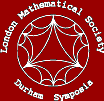 |
| Home |
| Outline |
| Participants |
| Programme |
 |
| London
Mathematical Society Durham Symposium |
| Dynamical Systems and Statistical Mechanics |
| Monday 3rd July - Thursday 13th July 2006 |
| Outline
More than 100 years after the formulation of statistical mechanics by Boltzmann, Gibbs, and many others the dynamical foundations of this theory are still subject of active research. The ultimate goal is to rigorously derive thermodynamic and statistical mechanics behaviour from the microscopic equations of motion. In recent years there has been considerable progress in the theory of dynamical systems, establishing various links to thermodynamic behaviour for simple model systems. From a rigorous mathematical point of view, the relaxation processes leading to equilibrium states are well understood for hyperbolic dynamical systems, and more complicated situations are subject of current research. Many interesting results on the spectrum of the Perron-Frobenius operator have been derived, and zeta-function techniques and period orbit theory have reached an advanced state. Several deterministic dynamical models exhibiting diffusion and thermodynamic-like behaviour have been studied in detail and some of their properties are well understood. Various types of functional central limit theorems have been derived for the iterates of sufficiently strongly mixing dynamical systems, which can ultimately help to justify some of the key assumptions of statistical mechanics. The proposed Durham symposium will concentrate onto the intersection between statistical mechanics and dynamical systems. There is variety of ways how both theories overlap. On the one hand, some results from dynamical systems (proved for simple model systems) can help to provide a rigorous foundation for some of the key issues studied in statistical mechanics (there relevant for more realistic physical situations). On the other hand, some formal mathematical methods borrowed from thermodynamics and statistical mechanics have turned out to be very successfull for the quantitative analysis and description of dynamical systems, in particular if these have fractal attractors or repellers. These methods, originating from the pioneering work of Sinai, Ruelle, and Bowen on the thermodynamic formalism of dynamical systems in the early seventies, have been further developed in the mean time and have attracted strong interest not only among mathematicians but also among physicists. The quantitative characterization of chaotic motion by thermodynamic means, the thermodynamic analysis of multifractal sets, the study of the spectrum of transfer operators and related questions are now a rapidly evolving branch of nonlinear science, with applications in many different subject areas. More recently, generalized statistical mechanics methods (based on more general entropy measures) have also been successfully applied to spatially extended dynamical systems exhibiting complex behaviour, as well as to nonequilibrium situations. These techniques generalize the concept of Boltzmann entropy and have many interesting applications for systems that interact with long-range interactions, or that possess spatial inhomogenities of the temperature field. The symposium will bring together people working on both pure and applied aspects of dynamical systems and statistical mechanics. It will stimulate discussion, interaction and collaboration between various theoretical and applied groups working in dynamical systems, statistical mechanics, and complexity. It is our intention to have a meeting that is attended by both, pure mathematicians and applied mathematicians/theoretical physicists. We hope that both groups will find a common language that will lead to new collaborations and new directions of research.
|
| Organising Committee: Christian Beck (Queen Mary), Carl Dettmann (Bristol) and Mark Pollicott (Warwick) |